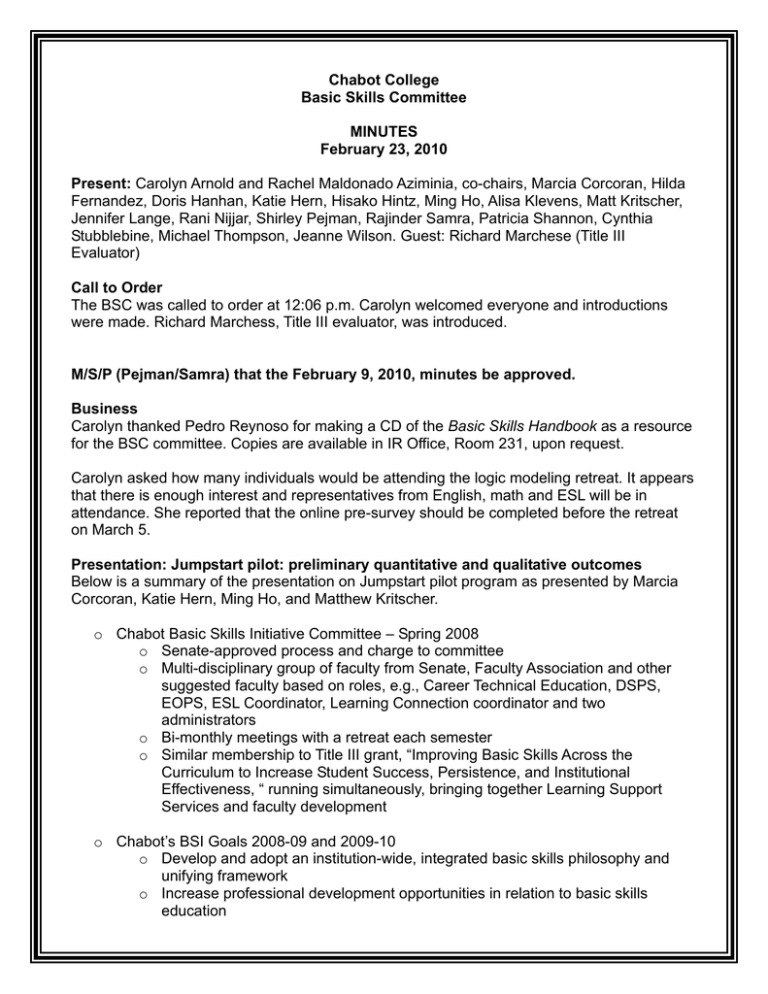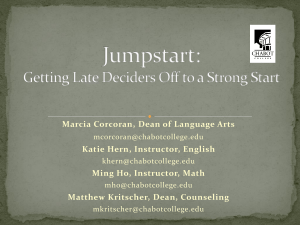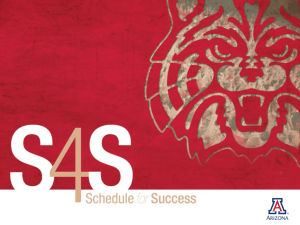Chabot College Basic Skills Committee MINUTES
advertisement

Chabot College Basic Skills Committee MINUTES February 23, 2010 Present: Carolyn Arnold and Rachel Maldonado Aziminia, co-chairs, Marcia Corcoran, Hilda Fernandez, Doris Hanhan, Katie Hern, Hisako Hintz, Ming Ho, Alisa Klevens, Matt Kritscher, Jennifer Lange, Rani Nijjar, Shirley Pejman, Rajinder Samra, Patricia Shannon, Cynthia Stubblebine, Michael Thompson, Jeanne Wilson. Guest: Richard Marchese (Title III Evaluator) Call to Order The BSC was called to order at 12:06 p.m. Carolyn welcomed everyone and introductions were made. Richard Marchess, Title III evaluator, was introduced. M/S/P (Pejman/Samra) that the February 9, 2010, minutes be approved. Business Carolyn thanked Pedro Reynoso for making a CD of the Basic Skills Handbook as a resource for the BSC committee. Copies are available in IR Office, Room 231, upon request. Carolyn asked how many individuals would be attending the logic modeling retreat. It appears that there is enough interest and representatives from English, math and ESL will be in attendance. She reported that the online pre-survey should be completed before the retreat on March 5. Presentation: Jumpstart pilot: preliminary quantitative and qualitative outcomes Below is a summary of the presentation on Jumpstart pilot program as presented by Marcia Corcoran, Katie Hern, Ming Ho, and Matthew Kritscher. o Chabot Basic Skills Initiative Committee – Spring 2008 o Senate-approved process and charge to committee o Multi-disciplinary group of faculty from Senate, Faculty Association and other suggested faculty based on roles, e.g., Career Technical Education, DSPS, EOPS, ESL Coordinator, Learning Connection coordinator and two administrators o Bi-monthly meetings with a retreat each semester o Similar membership to Title III grant, “Improving Basic Skills Across the Curriculum to Increase Student Success, Persistence, and Institutional Effectiveness, “ running simultaneously, bringing together Learning Support Services and faculty development o Chabot’s BSI Goals 2008-09 and 2009-10 o Develop and adopt an institution-wide, integrated basic skills philosophy and unifying framework o Increase professional development opportunities in relation to basic skills education o Expand and strengthen supplemental academic and counseling support in basic skills o Review data on student performance and literature on effective practices in developmental education o Develop and implement curricular changes to improve student outcomes o Jumpstart Program – Getting Late Deciders Off to a Strong Start o Target group First-time college student who apply after July 17 Population identified as at-risk Low fall to spring persistence Typically no matriculation services received Typically no access to developmental English and math in first semester—all sections are closed Typically late to apply for financial aid o Intervention Provided assessment, orientation, group counseling, and financial aid workshops Reserved section of developmental English Provided math workshop and allowed students to re-assess o Jumpstart Model o Psychology Counseling 25 Orientation held August 1 through 17 Counselors directed students to course package College Success Workshop – 1-unit course English 102, Reading, Reasoning and Writing (accelerated) – one semester course leading to transfer-level English – 4-unit course Math workshop – ALEKS, Learning/Assessment System, 1-unit course o Cost of Program serving 125 students o Costs of sections: 2.33 FTEF x $25,000 = $58,000 Five sections of College Success @ .066 FTEF each = .33 FTEF (1 hour lecture per week) Five sections of English 102 @ .35 FTEF each = 1.75 FTEF (3 hours lecture and 2 hours lab per week) Five sections of math workshop @ .05 FTEF each = .25 FTEF (1 hour lab per week o Cost of math software: $63.00 x 125 = $7,875 o Faculty Inquiry Group: $750.00 x 5 + $300.00 x 4 = $4,950 o Total cost: $71,075.00 o What the Literature Suggests: Representative Practices Guiding Us o Students receive early assessments and advisement. o Students are encouraged to take foundational English and math early in their college career. o Faculty who are both knowledgeable and enthusiastic about developmental education are recruited and hired to teach in the program. 2 o Counseling support provided is substantial, accessible, and integrated with academic courses and programs. o Reading and writing curricula are integrated. o Development of the whole person, social and emotional as well as cognitive growth, is important. o A high degree of structure is provided in the development of education courses. o Instructors share strategies. o Faculty and advisors closely monitor student performance. o Data guiding us o Higher persistence rates among students receiving matriculation services o Significantly more students persisted to and succeed in accelerated developmental English than in two-semester sequence o Accelerated students who get to transfer-level English pass at exactly the same rate as students who completed the two-semester track and actually about twice as many get there o Window into a Jumpstart Classroom o Video footage from Katie Hern’s English102 in fall 2009 was reviewed. Students are working collaboratively to understand the assigned reading, an excerpt from Paolo Freire’s Pedagogy of the Oppressed. It is the fourth class session. The discussion build on earlier readings about education by Malcolm X, Krishnamurti, and Mike Rose, along with a study by Anyon documenting serious differences between schools in different socio-economic communities. Guided discussion questions in which students engaged: What does Freire mean by the term “banking model” education? Why does he say it is “oppressive” or “dehumanizing”? What does Freire mean by “problem posing” education? Why does he say this is “liberatory”? o Emerging Results: English Faculty Inquiry Group o Five English instructors teaching in the program met twice a month and examined a range of data together. Challenge of homogeneous sections of “late arrivers,” first-time college group: all instructors reported higher withdrawal rates and lower success rates than is typical for them. Reasons behind low success rates: for the majority of students who did not complete or pass the course, the primary reason was not insufficient literacy skills for the accelerated track. Instead it was either external life factors (sudden homelessness, death in family, need to travel to Mexico) and/or old “high school behaviors” (e.g., trying to get by without doing homework). o Window into Jumpstart Math Workshop o 1-unit course in computer lab setting o ALEKS software program – assesses students’ existing knowledge and provides individualized curricula in their own zone of proximal development 3 o Workshop provides Review of prerequisites skills Shift in expectation of math class Understanding of college’s math offerings o Benefits of Math Workshop o Workshop setting instead of regular math class is less overwhelming o Low stress environment and flexible pacing safely tests student discipline and commitment o Computer system ALEKS works for all students Builds solid foundation Individualizes curriculum sequence Focuses on learning, not points Develops independent learning skills and strategies Allows moving ahead; appropriately challenges all students o Math Workshop Format o Students Take initial assessment in ALEKS Attend weekly lab hour Log three hours per week on ALEKS Get support in drop-in tutorial Take frequent assessment to monitor progress Retake Chabot math assessment o Instructors Review progress with students in lab Answer questions in lab/office hour Give help to individuals or small groups Explain Chabot’s math offerings o Data from Math Workshop o 132 students at census—some are not in Jumpstart o 114 students in analysis o 37 students completed the 40 required hours on ALEKS o 30 of those that have Chabot assessment data for both before and after workshop 15 placed the same 9 advanced 7 into one level above 2 into two levels above o Assessment placed most students in pre-algebra, elementary algebra, intermediate algebra. Only 3 student placed in transfer level math. o Three ALEKS courses were set up: pre-algebra, elementary algebra, intermediate algebra. o Poor results in the previous course in ALEKS suggest a second look at the assessment instrument. o Students were placed in ALEKS at one course below their assessment level to brush up on prerequisite skills: 4 No intermediate algebra student assessed over 50% in ALEKS elementary algebra Only about 20% of elementary algebra students assessed at least 50% in ALEKS pre-algebra In ALEKS pre-algebra assessment, the Q2 (37%) and Q3 (46.5%) for elementary algebra students are only15% higher than those for prealgebra students. o Next Steps: Math Improve Workshop Design o Consider other ways to effectively use individualized approach to expand students’ options within the math curriculum (possible options, shorten the workshop to 5 weeks while keeping the same format): To reduce student procrastination To give students a better sense of pace of regular math curse To identify students who can better benefit from self-paced format To allow students who can advance the opportunity to be reassessed before registration To allow multiple workshops through out the semester to catch dropouts from regular math courses o Next Steps: English Department o Use insights from Jumpstart to reconsider English development sequence How should we direct student toward the appropriated path—accelerated vs. two-semester track? Which students need a long sequence? What are their specific needs and does our current sequence meet them? Do we have the right balance of accelerated and non-accelerated sections? o Next Steps: All Areas o How might we support students confronted with external life challenges that pull them away from school? Are there alternative models of counseling that can be used to intervene in crucial moments? o How might classroom faculty work with these challenges? o How might we help students develop astronger sense of intrinsic motivation to meet the demands of college? o Emerging Data on Program Impact o Early census data shows higher persistence rates among first-time college student in Jumpstart: Fall 2009 to spring 2010 persistence New, first-time Jumpstart student: 72% (N=85) New, first-time non-Jumpstart students: 65% o Next Steps: Institutional o Reflect on ongoing data from Jumpstart experiment: Did taking English, math, and counseling in their first semester correlate with success in other courses? 5 How do Jumpstart student perform in English and math courses in future semester? o Continue to use basic skills committee to develop coordinated, institution-wide support for students. o Lessons Learned: Institutional o As new initiatives are developed within one campus group, ensure that the representatives on that group are sharing information in an ongoing way with departments, other institutional groups, and other administrators to facilitate smooth implementation. o Be intentional about aligning new initiatives with existing campus structures and timelines. o Replicable Components from Jumpstart o Directing students to enroll early in an accelerated English curriculum that integrates reading and writing and provides a one-semester track to collegeEnglish o Developing systems to increase students participation in assessment, orientation, and counseling o Using ALEKS to develop workshops to address student math skills o Using the Basic Skills Initiative Committee to develop an institution-wide initiative that crosses academic and student services as well as multiple disciplines and combines faculty development with learning support Comments following the presentation were: o Take the positive aspects of Jumpstart and replicate, but not necessarily replicate the Jumpstart program. o Students may not have appreciated the services that were being offered. o We may find something that works and it may not be for everyone, but we can find those students who may benefit from a strategy. o The Puente model of informing family members of the educational process may be one to replicate. o If students do not have a concrete goal of why they are in college they are less likely to be successful in college. How can we help students with this process? Adjournment The BSC adjourned at 1:02 p.m. Respectfully Submitted by Rachel Maldonado Aziminia 6



